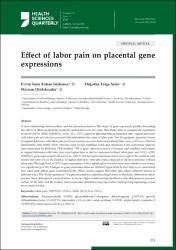| dc.contributor.author | Arıkan Söylemez, Evrim Suna | |
| dc.contributor.author | Arıöz, Dağıstan Tolga | |
| dc.contributor.author | Chkhikvadze, Mariam | |
| dc.date.accessioned | 2023-11-13T08:56:24Z | |
| dc.date.available | 2023-11-13T08:56:24Z | |
| dc.date.issued | 2023 | en_US |
| dc.identifier.citation | Söylemez, E. S. A., Arıöz, D. T., & Chkhikvadze, M. (2023). Effect of labor pain on placental gene expressions. HEALTH SCIENCES QUARTERLY, 3(4), 251-258. | en_US |
| dc.identifier.issn | 2791-6022 | |
| dc.identifier.uri | https://dx.doi.org/10.26900/hsq.2058 | |
| dc.identifier.uri | https://hdl.handle.net/20.500.12933/1720 | |
| dc.description.abstract | A close relationship between labor and the placenta is known. The study of gene expression profiles describing the effects of labor on placental tissue has accelerated in recent years. This study aims to compare the expression levels of GDF15, ADM, SERPINE1, NOS3, IL 6, TNF-α genes in placental tissues discarded after vaginal deliveries with labor pain and elective cesarean deliveries before the onset of labor pain. For this purpose, placental tissues of vaginal deliveries with labor pain (n=9) and elective cesarean deliveries without labor pain (n=9) were collected immediately after births. RNA extracted from tissues (umblical cords and deciduas). Gene expression analyzes were performed by Real-time PCR method. TNF-α gene expression levels in decidua and umblical cord tissues in vaginal deliveries with labor pain were higher than in elective cesareans without labor pain, and NOS3, ADM, SERPINE1 gene expression levels were low. GDF15 and IL-6 gene expression levels were high in the umblical cord tissues and were low in the decidua in vaginal deliveries with labor pain compared to elective cesareans without labor pain. The high level of GDF15 gene expression in the vaginal deliveries with labor pain umblical cord tissues was significant (p<0.05). Changes in gene expression between different types of birth may help us to understand how labor pain affects gene expression levels. These results suggest that labor pain affects different tissues in different ways. The “birth experience” of a placenta that has experienced pain stress is absolutely different to others process. Since birth pain is a natural stress, it can be a light in determining the effects of the differences in cesarean section on the baby and the mother. Gene expression alterations may cause labor starting and progressing, or just be an result of labor. | en_US |
| dc.language.iso | eng | en_US |
| dc.publisher | Holistence Publications | en_US |
| dc.relation.isversionof | 10.26900/hsq.2058 | en_US |
| dc.rights | info:eu-repo/semantics/openAccess | en_US |
| dc.subject | Labor Pain | en_US |
| dc.subject | SERPINET | en_US |
| dc.subject | GDF15 | en_US |
| dc.subject | ADM | en_US |
| dc.subject | NOS3 | en_US |
| dc.subject | IL-6 | en_US |
| dc.subject | Tumor Necrosis Factor-α (TNF-α) | en_US |
| dc.title | Effect of labor pain on placental gene expressions | en_US |
| dc.type | article | en_US |
| dc.authorid | 0000-0002-8550-793X | en_US |
| dc.department | AFSÜ, Tıp Fakültesi, Temel Tıp Bilimleri Bölümü, Tıbbi Biyoloji Ana Bilim Dalı | en_US |
| dc.contributor.institutionauthor | Arıkan Söylemez, Evrim Suna | |
| dc.contributor.institutionauthor | Arıöz, Dağıstan Tolga | |
| dc.identifier.volume | 3 | en_US |
| dc.identifier.issue | 4 | en_US |
| dc.identifier.startpage | 251 | en_US |
| dc.identifier.endpage | 258 | en_US |
| dc.relation.journal | Health sciences quarterly (Online) | en_US |
| dc.relation.publicationcategory | Makale - Ulusal Hakemli Dergi - Kurum Öğretim Elemanı | en_US |
















